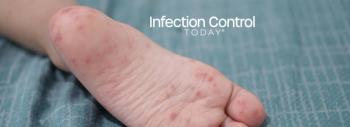
Frequent Handwashing Increases Risk for Irritant Contact Dermatitis
For the millions of healthcare workers in the United States, repeated handwashing may not seem like an occupational hazard at first glance. In fact, good hand hygiene is essential to stop the spread of infections such as staphylococcus and clostridium. However, new research examining the risk factors for irritant contact dermatitis a common skin condition marked by scaling, redness, itching and burning due to a chemical substance on the skin among healthcare workers finds that those who washed their hands more than 10 times per day were more likely to develop the condition than those who washed their hands less frequently.
Speaking at the 66th annual meeting of the American Academy of Dermatology, held Feb. 1-5 in San Antonio, dermatologist Susan T. Nedorost, MD, FAAD, associate professor of dermatology at University Hospitals Case Medical Center in Cleveland, Ohio, presented findings that demonstrated a positive link between frequent handwashing and irritant contact dermatitis, or hand dermatitis, among healthcare workers.
"We demonstrated that some people are predisposed to skin reactions to irritant detergents, and those who do wet work in low humidity conditions where frequent handwashing is an essential part of the job are very susceptible to hand dermatitis," said Nedorost. "Our findings confirm that healthcare workers who wash their hands repeatedly are at an increased risk of developing hand dermatitis, which can take months to heal. This knowledge can help workers at risk for the condition to practice good hand care and follow preventative tips to decrease their risk factors on the job."
Conducted in collaboration with the National Institute of Occupational Safety and Health (NIOSH), the study included a total of 100 healthcare workers in Cleveland, Ohio, who washed their hands at least eight times daily. Study participants were asked to complete a questionnaire to identify frequency of handwashing, use of alcohol-based cleansers, history of specific medical conditions (including asthma, eczema, and psoriasis, among others), and family history of dermatitis or eczema.
Patch tests to determine how easily the skin was irritated by detergents also were conducted on the study participants. Low concentrations of three common detergents were patch tested to predict which patients were at risk for hand dermatitis.
Data from the questionnaires and patch tests that were analyzed from 60 subjects who completed the study to date found that 63 percent of participants developed hand dermatitis. Specifically, 22 percent of participants who washed their hands more than 10 times per day developed hand dermatitis, compared to only 13 percent of those who washed their hands less than 10 times daily. The researchers determined that neither the use of an alcohol-based cleanser nor the use of gloves significantly influenced the development of hand dermatitis, and the other variables assessed in the questionnaire did not significantly alter susceptibility to hand dermatitis.
Some study participants had reactions to even low concentrations of detergent when patch tested, indicating that they were at increased risk for hand dermatitis, likely due to genetic factors. In addition, when analyzing the patch testing data, Nedorost determined that the most important factor in predicting those at risk for hand dermatitis was a reaction to the detergent sodium lauryl sulfate (SLS). Specifically, the large percentage of participants who reacted positively to SLS and developed hand dermatitis far outweighed the number of participants who did not react positively to SLS, but subsequently developed hand dermatitis.
A secondary goal of this study was to investigate possible associations of genetic variations in genes susceptible to hand dermatitis. The genetic analysis is not yet complete, but an example of a candidate gene that may play a role in hand dermatitis is filaggrin.
"Recently, genetic variants in the gene encoding filaggrin a protein that binds to cells in the outermost layer of skin known as the epidermis have been shown to be strong predisposing factors for atopic eczema, in which impaired skin barrier function plays a key role," explained Nedorost. "Variations in the filaggrin gene may cause a disturbance of the top layer of the skin, which serves as a barrier against environmental exposures such as frequent wetting and drying of the skin. Once the top layer of the skin cracks due to frequent wet/dry cycles, especially in conditions of low humidity where drying occurs rapidly, it results in inflammation. This is how irritant hand dermatitis begins."
Since environmental factors such as humidity and the need for good hand hygiene at work are beyond healthcare workers control, prevention is the key to warding off hand dermatitis.
Nedorost recommended the following tips for healthcare workers to help prevent hand dermatitis:
Cotton gloves should be worn under rubber or vinyl gloves for wet work to prevent perspiration from dampening the skin. The cotton gloves should be changed frequently if wet work is prolonged.
When appropriate, alcohol-based hand cleansers should be substituted for handwashing. These cleansers are well tolerated, but may cause temporary stinging when in contact with skin cracks.
A cream or ointment-based emollient should be applied immediately after water exposure before the skin is completely dry. The goal is to prevent rapid drying and cracking, so applying the emollient after the skin is dry is not nearly as beneficial.
Although patients often receive prescriptions for topical corticosteroids to treat symptoms of hand dermatitis, Nedorost cautions that evidence suggests that chronic use of topical steroids may reduce the skins ability to tolerate irritants, thins the skin, and increases bruising and tearing. "Topical steroids should never be used long-term as a substitute for emollients," added Nedorost. "Patients should consult a dermatologist for the proper treatment of hand dermatitis, particularly those who suspect their work environment may be the culprit."
Source: AmericanAcademy of Dermatology
Newsletter
Stay prepared and protected with Infection Control Today's newsletter, delivering essential updates, best practices, and expert insights for infection preventionists.






